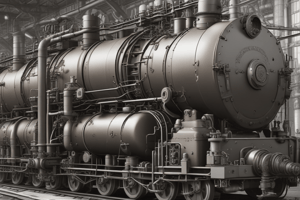Podcast
Questions and Answers
What is the acceptable color for a natural gas flame when conducting burner checks?
What is the acceptable color for a natural gas flame when conducting burner checks?
- Predominantly blue (correct)
- White plume
- Bright and symmetrical
- Bright yellow with orange tips
What does a white plume in the chimney during burner operation indicate?
What does a white plume in the chimney during burner operation indicate?
- Low fuel temperature
- Presence of water vapour from the combustion process (correct)
- Dirty burner nozzle
- Incorrect fuel-air ratio
What should the operator do if the boiler load increases?
What should the operator do if the boiler load increases?
- Ignore the increase in boiler load
- Call a certified technician
- Increase the fuel burned in the boiler furnace (correct)
- Decrease the amount of fuel burned in the boiler furnace
What is the purpose of blowing through the gauge glass and water column in a steam boiler?
What is the purpose of blowing through the gauge glass and water column in a steam boiler?
What is the recommended action if rust is evident in the gauge glass during steam boiler operation?
What is the recommended action if rust is evident in the gauge glass during steam boiler operation?
What does a weeping or simmering safety valve indicate in a steam boiler?
What does a weeping or simmering safety valve indicate in a steam boiler?
What is the primary reason for requiring continuous supervision of larger capacity steam boilers?
What is the primary reason for requiring continuous supervision of larger capacity steam boilers?
Which of the following must steam boiler operators attend to with vigilance?
Which of the following must steam boiler operators attend to with vigilance?
What is part of the operator’s regular inspections for steam boilers?
What is part of the operator’s regular inspections for steam boilers?
What are some of the routine activities that steam boiler operators must perform daily?
What are some of the routine activities that steam boiler operators must perform daily?
What are the principles that are the same for burner operation in hot water and steam boilers?
What are the principles that are the same for burner operation in hot water and steam boilers?
What is the purpose of bottom blowoff in routine operation procedures for steam boilers?
What is the purpose of bottom blowoff in routine operation procedures for steam boilers?
What is the purpose of soot blowing in a boiler?
What is the purpose of soot blowing in a boiler?
What may cause mild cases of foaming in a boiler?
What may cause mild cases of foaming in a boiler?
What should be done in persistent cases of foaming in a boiler?
What should be done in persistent cases of foaming in a boiler?
What is the purpose of draining the float chamber in a low water cut-off test?
What is the purpose of draining the float chamber in a low water cut-off test?
What should be done to prevent scale formation on the heating surfaces?
What should be done to prevent scale formation on the heating surfaces?
How can heat transfer efficiency be monitored in smaller plants?
How can heat transfer efficiency be monitored in smaller plants?
What should be monitored to ensure efficient heat transfer?
What should be monitored to ensure efficient heat transfer?
What is an indication of abnormal system water loss in a steam heating system?
What is an indication of abnormal system water loss in a steam heating system?
Flashcards are hidden until you start studying
Study Notes
Natural Gas Flame and Burner Checks
- Acceptable color for a natural gas flame is blue, indicating efficient combustion.
- A white plume in the chimney during burner operation suggests the presence of unburned fuel or excess moisture.
Boiler Load and Operations
- If boiler load increases, operators should check and adjust fuel input and water supply to maintain efficiency and safety.
Gauge Glass and Water Column
- Blowing through the gauge glass and water column ensures accurate readings and removes potential obstructions, preventing erroneous water level indicators.
Rust in Gauge Glass
- If rust is evident in the gauge glass during operation, immediate inspection of the boiler system is necessary to prevent corrosion-related failures.
Safety Valve Conditions
- A weeping or simmering safety valve indicates potential overheating or improper pressure levels in the steam boiler, requiring prompt attention to safety.
Continuous Supervision
- Continuous supervision of larger capacity steam boilers is crucial due to their increased risk of malfunction and the severity of potential accidents.
Operator Vigilance
- Steam boiler operators must vigilantly monitor water levels, pressure readings, and combustion efficiency to ensure safe and effective operation.
Regular Inspections
- Operators should regularly inspect components such as safety valves, water level indicators, and fuel supply systems as part of routine maintenance.
Daily Operator Activities
- Daily activities include checking water levels, inspecting pressure gauges, and testing safety valves to maintain overall boiler performance.
Burner Operation Principles
- Burner operation principles in both hot water and steam boilers involve consistent fuel-air mixture and proper combustion techniques for efficiency.
Bottom Blowoff Purpose
- The purpose of bottom blowoff in routine operation is to remove sediment and impurities from the boiler water, enhancing performance and longevity.
Soot Blowing
- Soot blowing is performed to clean boiler tubes and maintain heat transfer efficiency by removing accumulated soot and debris.
Foaming Causes
- Mild cases of foaming in a boiler may be triggered by impurities in the water or sudden changes in temperature and pressure.
Persistent Foaming Solutions
- In cases of persistent foaming, investigating and correcting water quality and chemical treatment processes is necessary to prevent operational issues.
Float Chamber Draining
- Draining the float chamber in a low water cut-off test is essential for ensuring the safety mechanism functions properly and prevents boiler dry firing.
Scale Formation Prevention
- To prevent scale formation on heating surfaces, maintaining proper water chemistry and regular blowdown procedures are recommended.
Heat Transfer Monitoring
- In smaller plants, heat transfer efficiency can be monitored by tracking temperature differentials and flow rates of the heating medium.
Efficient Heat Transfer Monitoring
- To ensure efficient heat transfer, operators should monitor system temperatures, pressures, and flow rates actively throughout boiler operation.
System Water Loss Indication
- Abnormal system water loss in a steam heating system is typically indicated by frequent need for make-up water, signaling potential leaks or inefficiencies.
Studying That Suits You
Use AI to generate personalized quizzes and flashcards to suit your learning preferences.




